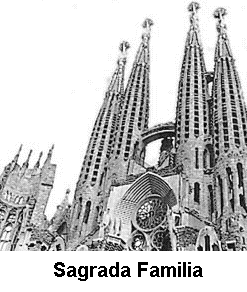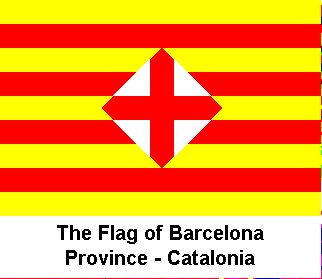"The patron saint of England is Saint George
and his feast day is celebrated on April 23rd. On this day his standard flies
from public buildings and a few patriotic souls wear a red rose and that, by and
large, is it. The words lack-lustre and luke-warm spring to mind. The patron
saint of Catalonia (or Catalunya if one is being correct) is also Saint George,
but the celebrations there are in a completely different league!
Last Saint George’s Day I was fortunate to be
in Barcelona, the capital of the "kingdom"  of Catalonia now a district
of Northern Spain. The Catalans are an extremely independent race. They speak
their own language (Catalan) and they will tell you in no uncertain terms that
"Catalunya is not part of Spain" .They are intensely proud of their
heritage and part of that heritage is their patron saint, Saint George.
of Catalonia now a district
of Northern Spain. The Catalans are an extremely independent race. They speak
their own language (Catalan) and they will tell you in no uncertain terms that
"Catalunya is not part of Spain" .They are intensely proud of their
heritage and part of that heritage is their patron saint, Saint George.
We descended the steps into the Metro Station to
take the train to the centre of the city. As it was a public holiday we expected
the populace to be relaxing at home at this time of the morning. Not so! the
station was thronged with people, dressed in their Sunday best all making their
way to the same destination - the Plaza de Saint Jaume (St James’ Square).
This is the heart of old Barcelona and here in the Middle Ages were built two
palaces. One is the seat of government of the city (the Town Hall) and the other
is the seat of the institution of autonomous government, the Palace of the
Generalitat de Catalunya dedicated to Saint George -naturally.. This building is
only open to the public on Saint George’s Day. We thought, therefore, that
this would be a unique opportunity for us to visit one of the most impressive
palaces of the city. On arrival in the square, it seemed to us that the whole of
Barcelona had come out to celebrate. A great seething mass of humanity in
holiday mood flowed around the building. The square was filled from corner to
corner with happy people enjoying the sunshine, meeting their friends, laughing
and singing - a real air of fiesta.. There was no chance of us getting into the
Palace, the queue went completely around the building so we moved on, into the
Plaza de la Seu, the small square outside the magnificent Gothic cathedral. One
could hardly move here. On a huge stage at the bottom of the Cathedral steps, a
band was playing and a good number of the populace were dancing the "sardanas"
- the national dance which is danced on a regular basis here as a statement of
Catalonia’s independence.
We had given up our idea of visiting the palace
by now so we edged past other statues of Saint George and made our way to
Barcelona’s concert hall, the Palau de Musica. Here it was somewhat quieter
and there was room to move. The term concert hall does not do this building
justice - it is more of a cathedral to music. Designed in 1908, it is considered
by many to be the crowning point of Modernist style. It is an incredible
building almost defying description - sufficient to say that here once again can
be found roses in abundance and yet another magnificent sculpture of Saint
George.
 Our next intention had been to stroll down La
Rambla and take in the atmosphere. This is a wide avenue, lined with shady lime
trees, and filled with open-air cafes, terraces, cinemas and art galleries. It
is along La Rambla de Catalunya the citizens of Barcelona stroll. It is also
famous for its flower, caged bird and book stalls. Saint George’s Day is very
good for business for the book sellers. The other side of the custom of ladies
receiving red roses from their menfolk is that the men receive books from their
ladies. The origin of this Saint George’s Day custom, we were informed, is
that on Saint George’s Day in 1616 our own William Shakespeare and Spain’s
Miguel de Cervantes died. I felt that it was very considerate of the Catalans to
include our Bard in their celebrations.
Our next intention had been to stroll down La
Rambla and take in the atmosphere. This is a wide avenue, lined with shady lime
trees, and filled with open-air cafes, terraces, cinemas and art galleries. It
is along La Rambla de Catalunya the citizens of Barcelona stroll. It is also
famous for its flower, caged bird and book stalls. Saint George’s Day is very
good for business for the book sellers. The other side of the custom of ladies
receiving red roses from their menfolk is that the men receive books from their
ladies. The origin of this Saint George’s Day custom, we were informed, is
that on Saint George’s Day in 1616 our own William Shakespeare and Spain’s
Miguel de Cervantes died. I felt that it was very considerate of the Catalans to
include our Bard in their celebrations.
In the evening we went out to dine in one of
Barcelona’s popular restaurants. All around us sat couples of all ages, the
ladies with their roses, the gentlemen with their books. It was Saint George and
Saint Valentine rolled into one. On the way home at midnight, they were still
selling roses by the metro steps (although the medical students had long since
gone home). The next day we saw girls and men on their way to work still
carrying their roses and books and there were still some Catalan flags flying.
It occurred to me that the good citizens of
Barcelona would be horrified to see how little we celebrate our mutual patron
saint. It’s a pity we don’t make more of April 23rd - I really enjoyed Saint
George’s Day - Barcelona style!
Barbara Hothersall
 of Catalonia now a district
of Northern Spain. The Catalans are an extremely independent race. They speak
their own language (Catalan) and they will tell you in no uncertain terms that
"Catalunya is not part of Spain" .They are intensely proud of their
heritage and part of that heritage is their patron saint, Saint George.
of Catalonia now a district
of Northern Spain. The Catalans are an extremely independent race. They speak
their own language (Catalan) and they will tell you in no uncertain terms that
"Catalunya is not part of Spain" .They are intensely proud of their
heritage and part of that heritage is their patron saint, Saint George. Our next intention had been to stroll down La
Rambla and take in the atmosphere. This is a wide avenue, lined with shady lime
trees, and filled with open-air cafes, terraces, cinemas and art galleries. It
is along La Rambla de Catalunya the citizens of Barcelona stroll. It is also
famous for its flower, caged bird and book stalls. Saint George’s Day is very
good for business for the book sellers. The other side of the custom of ladies
receiving red roses from their menfolk is that the men receive books from their
ladies. The origin of this Saint George’s Day custom, we were informed, is
that on Saint George’s Day in 1616 our own William Shakespeare and Spain’s
Miguel de Cervantes died. I felt that it was very considerate of the Catalans to
include our Bard in their celebrations.
Our next intention had been to stroll down La
Rambla and take in the atmosphere. This is a wide avenue, lined with shady lime
trees, and filled with open-air cafes, terraces, cinemas and art galleries. It
is along La Rambla de Catalunya the citizens of Barcelona stroll. It is also
famous for its flower, caged bird and book stalls. Saint George’s Day is very
good for business for the book sellers. The other side of the custom of ladies
receiving red roses from their menfolk is that the men receive books from their
ladies. The origin of this Saint George’s Day custom, we were informed, is
that on Saint George’s Day in 1616 our own William Shakespeare and Spain’s
Miguel de Cervantes died. I felt that it was very considerate of the Catalans to
include our Bard in their celebrations.